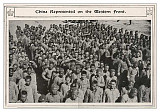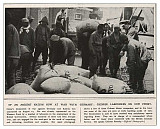Contents
In September 1914, when the war of movement had come to a halt and the front line had become a static system of trenches, the government and general staffs of the belligerent countries realized that the conflict was going to be long and costly. In order to bolster the war effort in the rearguard areas of the front, the armies of both sides called upon foreign labourers to relieve their soldiers of menial chores. In the case of the British Army, it created a Labour Corps of volunteer civilians which by 1918 comprised 100,000 Egyptians, 21,000 Indians and 20,000 South Africans working on the Western Front and in the Middle East theatre of war. In May 1916, bilateral agreements concluded between France and the United Kindom on the one hand and China on the other paved the way for Chinese labourers, mostly from the Manchurian provinces of Shandong and Jilin, to come to France and work under the authority of the Allied Armies. France also brought in labourers from Indo-China which had been a French colony since 1885.
Even though life in China was hard, what awaited the labourers in Europe was little more than exploitation. The British paid them a daily wage of just one franc for ten hours' work, six days a week. Despite being civilians they were subject to military law and accommodated in camps under the suspicious eyes of the British soldiers. Relations between the workers and the soldiers were exacerbated by a lack of communication, made even worse by the fact that the dialect spoken by the Chinese varied greatly from official Mandarin.
Initially the inhabitants of the region looked upon them with curiosity but this soon turned to wariness and downright fear following a number of petty offences committed by the Chinese in the villages surrounding their camps. Numerous police reports, especially in the region of Saint-Omer, make mention of thefts, fights, and gunfire involving the labourers. In the same vein, the British punished them with fines and prison sentences for any breach of the rules––which they could not understand anyway––such as absence without leave, theft, desertion or using violence against a superior officer. Xenophobia began to take hold in the region to a point where the prefect of Pas-de-Calais formally requested in September 1919 that his department be "delivered" from this workforce which "terrorized" the population.
Despite the incidents and the bad feeling directed towards them, the Chinese workers contributed greatly to the war economy both on the front and in the rear. In 1918 Northern France had seventeen Labour Corps camps which housed nearly 96,000 men. The main camps were situated on the coast at Boulogne-sur-Mer, Wimereux and Étaples where the Chinese labourers worked in the ports unloading British supply ships. The French Army employed them to do the same work in the ports of Calais and Dunkirk. They also worked in weapons and munitions factories, in shipyards and in factories building mechanical parts and aeroplanes. They built and repaired roads and railways, a notable example being the railways which ran to the front in Artois and Somme. They were employed as lumberjacks in the forests around the Audomarois marshes and as miners in the collieries under British control. On the front they dug trenches and built parapets.
In March 1919 there were nearly 80,000 Chinese in France and Belgium working on the reconstruction of the war-damaged areas. Under orders to clean up the battlefields, they were involved in mine clearing operations and digging up the bodies of dead soldiers and transferring them to the new military cemeteries. After the war they were gradually returned to China and by 1921 only 3,000 were left in France. Most of those who remained worked in factories on the outskirts of Paris and were the founding fathers of what was to become Paris's first Chinatown.
In total around 7,900 labourers from China and Indo-China died in France between 1916 and 1919––mostly from disease, enemy fire or exhaustion––and their bodies now rest in the military cemeteries of the armies they served during the Great War.
Sources :
- Serge THOMAS, « Les travailleurs chinois dans le Pas-de-Calais pendant la Première Guerre Mondiale », revue Gauheria n°55
- « The Chinese Labour Corps at the Western Front », rapport de la Commonwealth War Graves Commission
Edouard ROOSE
External links
Archive pictures

The War Illustrated (27th July, 1918) on ww.greatwardifferent.com (jpg - 0.06 MB)
The Chinese Labour Corps

The War Illustrated (27th July, 1918) on ww.greatwardifferent.com (jpg - 0.04 MB)
The Chinese Labour Corps at work

The War Illustrated (27th July, 1918) on ww.greatwardifferent.com (jpg - 0.05 MB)
The Chinese Labour Corps at work
Documents
"The Chinese Labour Corps in France 1917-1921" by Brian C. Fawcett, article published in the Journal of the Hong Kong Branch of the Royal Asiatic Society Vol. 40 (2000)
Hong Kong University Libraries / Hong Kong Journal Online (pdf - 7.2 MB)
The Chinese Labour Corps at the Western Front
Information Sheet of the Commonwealth War Graves Commission (pdf - 0.49 MB)




